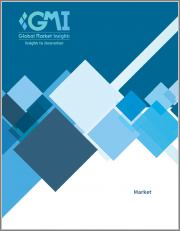
분변잠혈 검사 시장 규모는 2023-2032년 CAGR 7.3%를 기록할 것으로 추정됩니다.
이러한 현상은 질병 조기 발견의 중요성을 강조하는 대중 인식 캠페인과 헬스케어 구상 증가에 기인합니다.
정확성과 신뢰성을 높인 보다 민감하고 특이적인 검사 시장 개척 등 분변잠혈 검사 기술의 지속적인 발전이 시장 성장에 기여하고 있습니다. 또한 업계 관계자들은 새로운 유전자 검사법 도입을 통해 암 검진 현대화 및 의료 결과 개선을 위한 전략적 구상을 시행하고 있습니다. 일례로 2023년 8월, 분자 유전학 진단 회사인 Mainz Biomed NV는 폴란드에서 ColoAlert(R)의 상업적 출시를 위해 testDNA와 파트너십을 체결했습니다.
변 잠혈 검사 시장은 검사 유형, 최종 용도 및 지역으로 분류됩니다.
검사 유형별로는 2023-2032년 측면 흐름 면역 FOB 부문이 업계 가치를 견인할 것으로 예상됩니다. 이러한 성장은 대변 샘플에서 숨겨진 혈액을 조기에 발견하는 비침습적 검사의 채택이 증가하면서 대장암을 포함한 소화기 질환의 중요한 검진 툴로 활용되고 있기 때문입니다. 사용자 편의성, 높은 민감도, 예방적 의료 조치에 대한 특이성 등의 장점도 이 부문의 성장에 기여하고 있습니다.
종합적인 의료 서비스를 제공하기 위한 환자 관리 및 진단의 개선으로 병원 최종 용도 분야의 분변잠혈 검사 시장 규모는 2032년까지 빠른 속도로 성장할 것으로 예상됩니다. 예방 의료와 질병 조기 발견에 대한 관심이 높아짐에 따라 병원은 대변 잠혈 검사를 대장암 및 소화관 출혈을 포함한 다양한 소화기 질환의 일상적인 선별 검사 툴로 채택하고 있습니다.
아시아태평양의 대변 잠혈 검사 시장은 2023-2032년 주목할 만한 CAGR로 성장할 것으로 예상됩니다. 이러한 배경에는 위장 건강에 대한 인식 증가, 대장암 발병률 증가, 주민 기반 검진 프로그램 시행 등이 있습니다. 암 예방에 대한 장기적인 교육 및 인식 제고 프레임워크를 구축하기 위해 아시아 국가들의 국립 암 센터들 간에 여러 협력적 노력이 이루어지고 있는 것도 시장 성장에 영향을 미치고 있습니다. 예를 들어 중국, 인도, 인도네시아, 일본, 한국, 몽골, 싱가포르, 태국, 베트남 등이 적극적으로 참여하고 있는 Asian National Cancer Centers Alliance(ANCCA)는 2020-2031년까지 암 등록을 위한 아시아 특유의 의료 암 등록을 위한 아시아 고유의 의료 표준 프로토콜을 포함한 ANCCA의 세 가지 부문을 계획하고 있습니다.
Fecal Occult Testing Market size is estimated to record 7.3% CAGR from 2023-2032 attributed to the growing number of public awareness campaigns and healthcare initiatives emphasizing the importance of early disease detection.
The ongoing advancements in fecal occult testing technologies, such as the development of more sensitive and specific tests with improved accuracy and reliability are contributing to the market growth. Furthermore, industry participants are implementing strategic initiatives to modernize cancer screening and improve healthcare outcomes through the implementation of novel genetic testing methods. To cite an instance, in August 2023, Mainz Biomed NV, a molecular genetics diagnostic firm, partnered with testDNA for the commercial launch of ColoAlert® in Poland in a bid to advance new and innovative testing alternatives to neglected groups.
The fecal occult testing market is segmented in terms of test type, end-use, and region.
With respect to test type, the industry value from the lateral flow immuno FOB segment is expected to gain traction from 2023 to 2032. The growth can be attributed to the rising adoption of this non-invasive test in the early detection of hidden blood in stool samples, serving as vital screening tool for gastrointestinal conditions, including colorectal cancer. Benefits, such as user-friendly nature, high sensitivity, and specificity in preventive healthcare measures will also contribute to the segment growth.
Fecal occult testing market size from the hospitals end-use segment will grow at significant pace by 2032 due to the presence of improved patient care and diagnostics to offer comprehensive healthcare services. With the increasing focus on preventive healthcare and early disease detection, hospitals are adopting fecal occult testing as routine screening tool for various gastrointestinal disorders, including colorectal cancer and gastrointestinal bleeding.
Asia Pacific fecal occult testing market is set to expand at notable CAGR from 2023 to 2032. This is attributed to the increasing awareness about gastrointestinal health, rising incidences of colorectal cancer, and the implementation of population-based screening programs. Several collaboration efforts among several national cancer centers in Asian countries for creating long-term framework for education and awareness about cancer prevention will influence the market growth. For instance, the Asian National Cancer Centers Alliance (ANCCA) with active participating members, such as China, India, Indonesia, Japan, Korea, Mongolia, Singapore, Thailand, and Vietnam planned three segments of ANCAA from 2020 to 2031, including the protocol for Asian-specific medical standards for cancer registries.